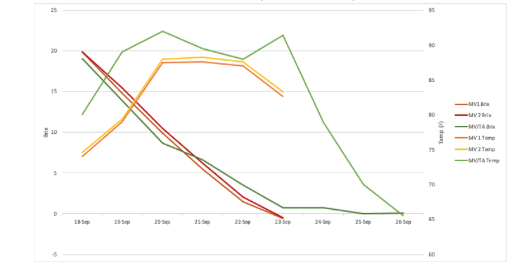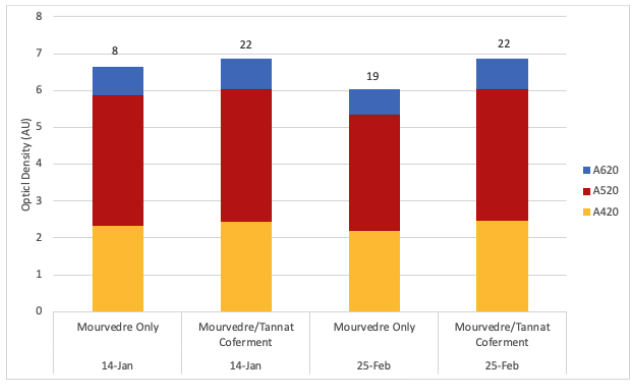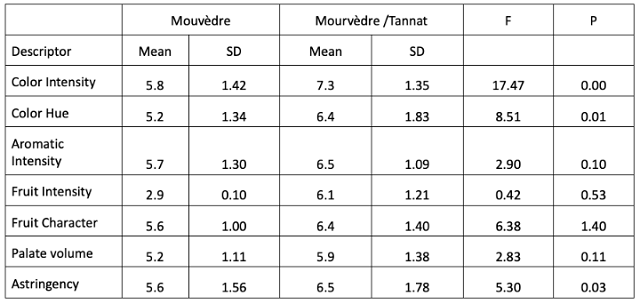Exploring the effects of co-fermentation in Mourvèdre (2021)
Michael Heny
Michael Shaps Wineworks
Summary
Despite producing full-bodied, meaty wines in its home region, Mourvèdre only enjoys mixed success in Virginia. To increase the body, structure and perception of ripeness in a Mourvèdre-based red wine, this variety was co-fermented with 12% Tannat. The resulting wine had higher measured color intensity and notably higher tannins and polymeric anthocyanins than the 100% Mourvèdre wine. The wines were significantly different in a triangle test, with the cofermented wine receiving higher scores for color intensity, color hue, and astringency.
Introduction
Mourvèdre (aka Monastrell) likely originated in Saguntao in the Camp de Morvedre region of Valencia Spain. In its home region, Mourvèdre produces full bodied, meaty wines with aromas of dark fruits and flowers1. Several sources mention its propensity to reduction1,2.
Mourvèdre has several characteristics that lead to mixed success in Virginia. It is cold tender, limiting its range. On the positive side, it buds relatively late, making it less susceptible to spring frost. However, it also ripens late, requiring 180 frost free days, and requires high temperatures at the end of the growing season to reach its full potential. This can lead to problems with late season rains and onset of cooler temperatures. Its late ripening can also tend toward lower phenolic maturity in cooler years. Mourvèdre has large, compact clusters and tends toward high fertility. It does have tough skins that provide good resistance to Botrytis and Phomopsis, however it is susceptible to sour rot2, downy and powdery mildew3. So little Mourvèdre is planted in Virginia that that variety is not included in the Commercial Grape report. However, several vineyards have small plantings.
In the 2020 season, Michael Heny at Wineworks experimented with the co-fermentation of Mourvèdre from Upper Shirley Vineyards with pressed skins from Viognier grapes. The intention of this approach was twofold: to produce a lighter bodied red wine for a client with many full bodied red wines and to utilize the cofactors potentially found in Viognier to stabilize color and phenolics in Mourvèdre (à lá Southern Rhône). The inclusion of Viognier skins led to an increase in pH in the finished wine (3.72 vs. 3.85) as well as a potential increase in anthocyanins and tannins. In a triangle test, 16 out of 33 participants were able to tell the difference between the wines, indicating that co-fermented wine was significantly different. When asked how they could tell the difference, respondents noted differences in aromatics , with the Viognier co-ferment having more floral aromatics as well as lighter body. However, there were no significant differences in descriptive scores between the wines for floral character, fruit character, intensity of spice, or perception of tannin.
Though the Mourvèdre/Viognier co-ferment led to an interesting wine, it was not in line with the wine style goal for this product, which is to produce a playful, early bottling (March/April) red wine packaged in a clear bottle that still has some body and structure. In the 2020 experiment, one barrel was topped with Tannat wine, leading to notably higher color intensity, closer to the goal for this wine. In 2021, Mourvèdre was co-fermented with Tannat. Tannat was chosen as a co-fermentation partner in order to bring additional body and structure, and potentially shift the fruit profile to one of greater ripeness (from bright red to darker red fruits).
Methods
Mourvèdre (2.3 tons) was hand harvested on 9/16 and refrigerated overnight before processing. A small amount of Tannat (0.17 tons) was picked on the same day as Mourvèdre. Two Tbins were filled with Mourvèdre only while a third was filled with Mourvèdre + Tannat at a rate of 12% Tannat. Aside from fruit composition, all other operations were the same between bins. At processing, SO2, Color Pro (60 ml/ton), Tanin VR Supra (24 g/hL), and Canadell M+ French Oak Chips (2 g/L) were added to each bin with care taken to avoid mixing tannin, enzyme, and SO2. Each TBin was inoculated with ICV GRE yeast (20 g/hL) rehydrated in Go Ferm (15 g/hL). Nitrogen addition was done at the end of lag phase. Tartaric acid (0.5 g/L) was also added at that time. Two days later, wine was chaptalized with 30 g/L and another nitrogen addition was done for a total of 10 g/hL Superfood and 3 g/hL DAP. Wine was pressed after Brix readings became negative (on 9/21). Wine was allowed to settle before transfer to neutral French oak barrels for malolactic fermentation. Malic acid depletion was complete by 11/1. Wine was treated with SO2 on 11/5.
Sensory analysis was completed by a panel of 21 wine producers. Due to restrictions put in place during COVID-19, sensory analysis was completed using shipped samples. Each wine producer received three wines in identical bottles, filled on the same day, each coded with random numbers. Two of the bottles contained the same wine while the third bottle contained the different wine. Participants were asked to identify which wine was different (a triangle test). There were four tasting groups with the unique wine in the triangle test balanced among the groups. Participants were then asked to score each wine on a scale of 0 to 10 for color intensity, color hue, aromatic intensity, fruit intensity, fruit character (defined as a range of bright/fresh/red to dark/dried/black), palate volume, and astringency. They were also given open ended questions to describe the wines. Results for the triangle test were analyzed using a one-tailed Z test. Descriptive scores were analyzed using repeated measures ANOVA.
Results
Addition of 12% Tannat led to only small changes in the chemistry of the must (Table 1). The TBin that contained the co-fermentation had more heat than the two bins containing Mourvèdre only (Figure 1). Fermentation kinetics stalled somewhat in the co-fermentation bin, leading to a longer time needed to complete fermentation. There are few differences in finished wine chemistry (Table 2). The co-fermented wine has higher alcohol, however this could be due to differences in yield leading to differential chaptalization. This wine also has slightly higher volatile acidity. This may be due to stress of higher temperature fermentation, or longer time to achieve Brix dryness. All of the wines have a small amount of residual sugar.
Wine color is influenced by many factors, including pH and SO2. These wines have very similar pH values, and SO2 values (shown as endcaps in Figure 2) were very similar at the 2/25 sampling, which allows some comparisons to be made. In this case, the color intensity (sum of A420, A520 and A620nm readings) is higher in the co-fermented wine. Phenolic measurements are all slightly higher for the co-fermented wine (Table 3). Notably, tannin levels increased from 456 mg/L to 528 mg/L with the addition of Tannat, an increase of 16%. The formation of polymeric anthocyanins, the stable form of anthocyanins, depends on tannin availability. These increased 20% in the co-fermentation with Tannat.
In a triangle test, 12 out of 21 respondents were able to distinguish which wine was different, indicating the wines were significantly different (Z=2.08, p= 0.02). The cofermented wine had significantly higher scores for color intensity, color hue, and astringency. There were no significant differences in scores for aromatic intensity, fruit intensity, fruit character or palate volume (Table 4).
Table 1: Must analysis for two treatments of Mourvèdre (in-house data)

Figure 1: Fermentation kinetics for two bins of Mourvèdre and one bin of Mourvèdre/Tannat co-ferment (in-house data)

Table 2: Finished wine chemistry for two treatments of Mourvèdre (ICV Labs)

Figure 2: Optical density for two treatments of Mourvèdre at two time points (ICV labs)

Table 3: Phenolic measurements (mg/L) for two treatments of Mourvèdre (ETS labs)

Table 4: Statistical analysis for descriptive scores from blind sensory analysis of cofermentation in Mouvèdre

References
(1) Puckette, M. Diversify Your Taste With Mouvèdre Wine. Wine Folly, n.d.
(2) Robinson, J.; Harding, J.; Vouillamoz, J. Wine Grapes: A Complete Guide to 1368 Vine Varieties, Including Their Origins and Flavours, Illustrated Edition.; The Penguin Group: New York, 2012.
(3) Wolf, T. K. Wine Grape Production Guide for Eastern North America; Plant and Life Sciences Publishing: Ithaca, New York, 2008.
